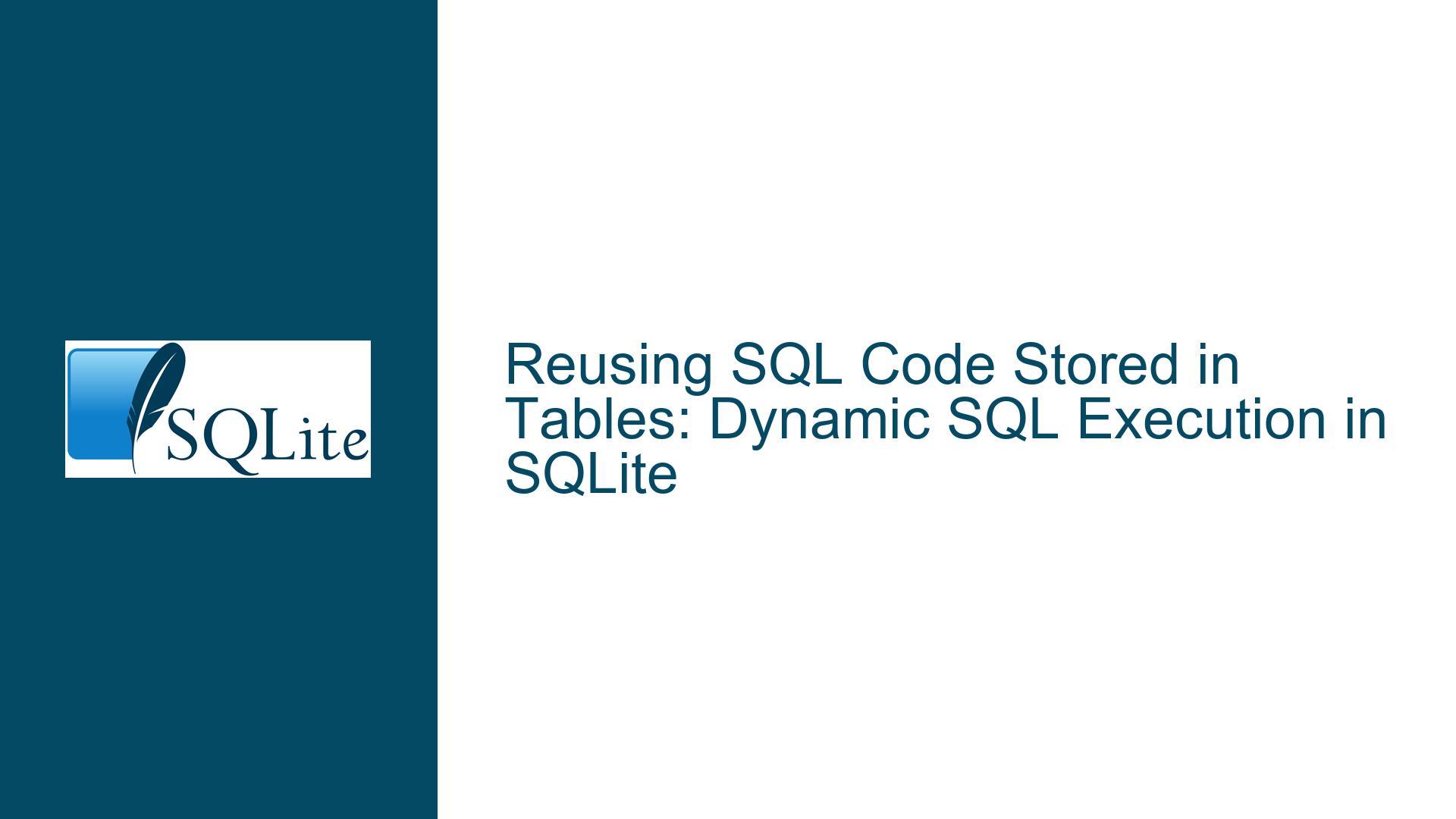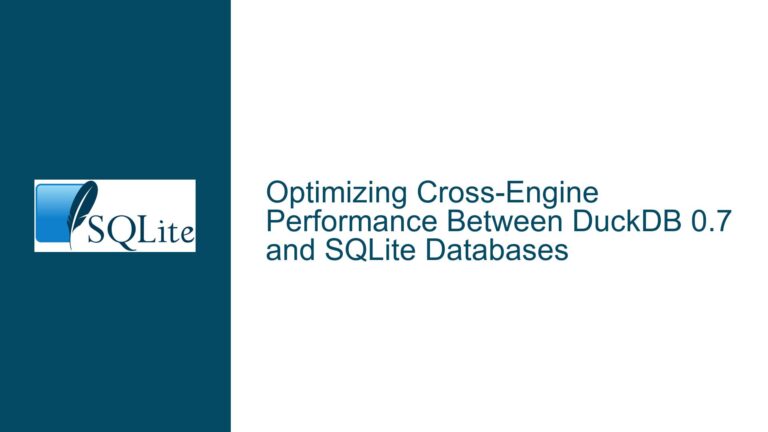Reusing SQL Code Stored in Tables: Dynamic SQL Execution in SQLite
Dynamic SQL Execution from Table Cells in SQLite
SQLite is a powerful, lightweight database engine that supports a wide range of SQL features. However, one of its limitations is the inability to directly execute SQL code stored within table cells. This limitation often arises in scenarios where developers want to store SQL snippets or conditions in a table and later reuse them dynamically in queries. For example, consider a scenario where a table user_pricings stores pricing logic as SQL conditions, and another table users contains user data. The goal is to dynamically apply the pricing logic stored in user_pricings to the data in users.
The challenge lies in the fact that SQLite does not natively support the execution of SQL code stored in table cells. While SQLite provides extensions like eval() and features like generated columns, these solutions may not always be feasible due to version constraints or the inability to use extensions in certain environments. This post delves into the core issue, explores possible causes, and provides detailed troubleshooting steps and solutions to address the problem of dynamically executing SQL code stored in table cells.
Interrupted SQL Code Execution Due to Lack of Native Support
The primary issue stems from SQLite’s lack of native support for executing SQL code stored within table cells. In the example provided, the user_pricings table stores a SQL condition as a text string, and the goal is to dynamically apply this condition to the users table. However, SQLite does not provide a built-in mechanism to interpret and execute the SQL code stored in the condition column of the user_pricings table.
One might attempt to use a subquery to retrieve the SQL condition and then execute it, but this approach fails because SQLite does not support the direct execution of SQL code retrieved from a table cell. For instance, the query SELECT *, (SELECT condition FROM user_pricings) FROM users; does not work as intended because the condition column is treated as a string rather than executable SQL code.
Another approach is to use the eval() function, which is available as an extension in SQLite. The eval() function can execute SQL code dynamically, but it requires the SQL code to be well-formed and properly parameterized. However, the eval() function is not available in all SQLite environments, particularly in older versions or restricted environments where extensions cannot be used.
Generated columns, introduced in SQLite 3.31.0, offer another potential solution. Generated columns allow you to define columns whose values are computed based on expressions or other columns in the table. However, generated columns are not available in older versions of SQLite, such as version 3.16, which is still widely used in many applications.
Implementing Dynamic SQL Execution with Application Logic
Given the limitations of SQLite, the most reliable solution is to implement dynamic SQL execution within the application logic. This approach involves retrieving the SQL code stored in the table, constructing the final query within the application, and then executing the query against the database.
To illustrate this approach, consider the following steps:
Retrieve the SQL Condition from the Table: First, retrieve the SQL condition stored in the
user_pricingstable. This can be done using a simpleSELECTquery:SELECT condition FROM user_pricings;This query returns the SQL condition as a string, which can then be processed within the application.
Construct the Final Query: Once the SQL condition is retrieved, construct the final query by embedding the condition into the desired SQL statement. For example, if the condition is
CASE WHEN age < 18 THEN 42.00 ELSE 55.00 END, the final query would be:SELECT *, CASE WHEN age < 18 THEN 42.00 ELSE 55.00 END FROM users;This query can be constructed as a string within the application and then executed against the database.
Execute the Final Query: Execute the constructed query against the SQLite database. This can be done using the appropriate database API or library in the application’s programming language. For example, in Python using the
sqlite3module:import sqlite3 # Connect to the SQLite database conn = sqlite3.connect('example.db') cursor = conn.cursor() # Retrieve the SQL condition from the user_pricings table cursor.execute('SELECT condition FROM user_pricings') condition = cursor.fetchone()[0] # Construct the final query final_query = f'SELECT *, {condition} FROM users' # Execute the final query cursor.execute(final_query) results = cursor.fetchall() # Process the results for row in results: print(row) # Close the connection conn.close()Handle Edge Cases and Errors: Ensure that the application handles edge cases and errors gracefully. For example, if the SQL condition retrieved from the
user_pricingstable is malformed or contains syntax errors, the application should catch these errors and handle them appropriately. Additionally, consider validating the SQL condition before executing it to prevent SQL injection attacks or other security vulnerabilities.Optimize Performance: Depending on the complexity of the SQL condition and the size of the
userstable, the dynamic SQL execution approach may introduce performance overhead. To optimize performance, consider caching the SQL condition within the application or using prepared statements to reduce the overhead of query construction and execution.
By implementing dynamic SQL execution within the application logic, developers can overcome the limitations of SQLite and achieve the desired functionality without relying on extensions or features that may not be available in all environments. This approach provides flexibility and control, allowing developers to tailor the solution to their specific requirements and constraints.
Conclusion
Dynamic SQL execution from table cells is a common requirement in many applications, but SQLite’s lack of native support for this feature presents a significant challenge. While extensions like eval() and features like generated columns offer potential solutions, they may not always be feasible due to version constraints or environmental restrictions. The most reliable approach is to implement dynamic SQL execution within the application logic, retrieving the SQL condition from the table, constructing the final query, and executing it against the database. This approach provides flexibility, control, and compatibility with older versions of SQLite, ensuring that the desired functionality can be achieved in a wide range of environments.






